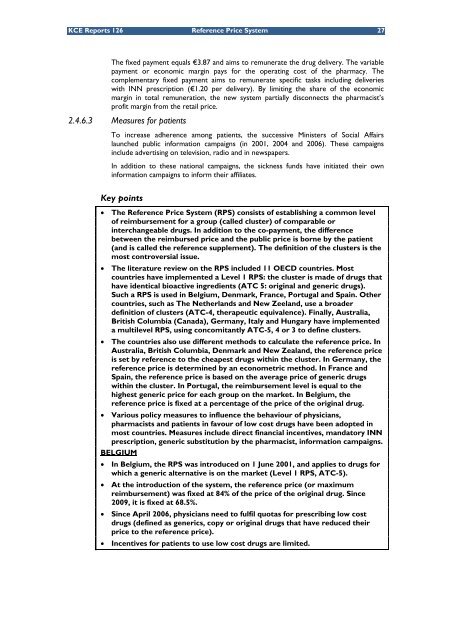The reference price system and socioeconomic differences in ... - KCE
The reference price system and socioeconomic differences in ... - KCE
The reference price system and socioeconomic differences in ... - KCE
Create successful ePaper yourself
Turn your PDF publications into a flip-book with our unique Google optimized e-Paper software.
<strong>KCE</strong> Reports 126 Reference Price System 27<br />
<strong>The</strong> fixed payment equals €3.87 <strong>and</strong> aims to remunerate the drug delivery. <strong>The</strong> variable<br />
payment or economic marg<strong>in</strong> pays for the operat<strong>in</strong>g cost of the pharmacy. <strong>The</strong><br />
complementary fixed payment aims to remunerate specific tasks <strong>in</strong>clud<strong>in</strong>g deliveries<br />
with INN prescription (€1.20 per delivery). By limit<strong>in</strong>g the share of the economic<br />
marg<strong>in</strong> <strong>in</strong> total remuneration, the new <strong>system</strong> partially disconnects the pharmacist’s<br />
profit marg<strong>in</strong> from the retail <strong>price</strong>.<br />
2.4.6.3 Measures for patients<br />
To <strong>in</strong>crease adherence among patients, the successive M<strong>in</strong>isters of Social Affairs<br />
launched public <strong>in</strong>formation campaigns (<strong>in</strong> 2001, 2004 <strong>and</strong> 2006). <strong>The</strong>se campaigns<br />
<strong>in</strong>clude advertis<strong>in</strong>g on television, radio <strong>and</strong> <strong>in</strong> newspapers.<br />
In addition to these national campaigns, the sickness funds have <strong>in</strong>itiated their own<br />
<strong>in</strong>formation campaigns to <strong>in</strong>form their affiliates.<br />
Key po<strong>in</strong>ts<br />
• <strong>The</strong> Reference Price System (RPS) consists of establish<strong>in</strong>g a common level<br />
of reimbursement for a group (called cluster) of comparable or<br />
<strong>in</strong>terchangeable drugs. In addition to the co-payment, the difference<br />
between the reimbursed <strong>price</strong> <strong>and</strong> the public <strong>price</strong> is borne by the patient<br />
(<strong>and</strong> is called the <strong>reference</strong> supplement). <strong>The</strong> def<strong>in</strong>ition of the clusters is the<br />
most controversial issue.<br />
• <strong>The</strong> literature review on the RPS <strong>in</strong>cluded 11 OECD countries. Most<br />
countries have implemented a Level 1 RPS: the cluster is made of drugs that<br />
have identical bioactive <strong>in</strong>gredients (ATC 5: orig<strong>in</strong>al <strong>and</strong> generic drugs).<br />
Such a RPS is used <strong>in</strong> Belgium, Denmark, France, Portugal <strong>and</strong> Spa<strong>in</strong>. Other<br />
countries, such as <strong>The</strong> Netherl<strong>and</strong>s <strong>and</strong> New Zeel<strong>and</strong>, use a broader<br />
def<strong>in</strong>ition of clusters (ATC-4, therapeutic equivalence). F<strong>in</strong>ally, Australia,<br />
British Columbia (Canada), Germany, Italy <strong>and</strong> Hungary have implemented<br />
a multilevel RPS, us<strong>in</strong>g concomitantly ATC-5, 4 or 3 to def<strong>in</strong>e clusters.<br />
• <strong>The</strong> countries also use different methods to calculate the <strong>reference</strong> <strong>price</strong>. In<br />
Australia, British Columbia, Denmark <strong>and</strong> New Zeal<strong>and</strong>, the <strong>reference</strong> <strong>price</strong><br />
is set by <strong>reference</strong> to the cheapest drugs with<strong>in</strong> the cluster. In Germany, the<br />
<strong>reference</strong> <strong>price</strong> is determ<strong>in</strong>ed by an econometric method. In France <strong>and</strong><br />
Spa<strong>in</strong>, the <strong>reference</strong> <strong>price</strong> is based on the average <strong>price</strong> of generic drugs<br />
with<strong>in</strong> the cluster. In Portugal, the reimbursement level is equal to the<br />
highest generic <strong>price</strong> for each group on the market. In Belgium, the<br />
<strong>reference</strong> <strong>price</strong> is fixed at a percentage of the <strong>price</strong> of the orig<strong>in</strong>al drug.<br />
• Various policy measures to <strong>in</strong>fluence the behaviour of physicians,<br />
pharmacists <strong>and</strong> patients <strong>in</strong> favour of low cost drugs have been adopted <strong>in</strong><br />
most countries. Measures <strong>in</strong>clude direct f<strong>in</strong>ancial <strong>in</strong>centives, m<strong>and</strong>atory INN<br />
prescription, generic substitution by the pharmacist, <strong>in</strong>formation campaigns.<br />
BELGIUM<br />
• In Belgium, the RPS was <strong>in</strong>troduced on 1 June 2001, <strong>and</strong> applies to drugs for<br />
which a generic alternative is on the market (Level 1 RPS, ATC-5).<br />
• At the <strong>in</strong>troduction of the <strong>system</strong>, the <strong>reference</strong> <strong>price</strong> (or maximum<br />
reimbursement) was fixed at 84% of the <strong>price</strong> of the orig<strong>in</strong>al drug. S<strong>in</strong>ce<br />
2009, it is fixed at 68.5%.<br />
• S<strong>in</strong>ce April 2006, physicians need to fulfil quotas for prescrib<strong>in</strong>g low cost<br />
drugs (def<strong>in</strong>ed as generics, copy or orig<strong>in</strong>al drugs that have reduced their<br />
<strong>price</strong> to the <strong>reference</strong> <strong>price</strong>).<br />
• Incentives for patients to use low cost drugs are limited.
















